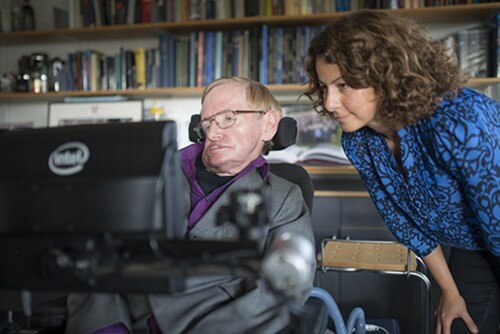The new system replaces the one that was used by Prof. Hawking for decades, it is easier to use, intuitive and has the power to contribute to the sense of independence of amputees • Until January 2015, Intel will make the system open source for use by researchers and technologists as a customizable solution for about 3 A million amputees in the world

Intel demonstrated today for the first time, together with Professor Stephen Hawking, a new communication platform that it developed for him and replaces the one that had been in use for decades. The new system, which clearly improves the comfort of communication for paraplegics, will be made available to members of the medical research community in open source starting next month so that they can be adapted for use by the approximately 3 million paraplegics in the world.
For the purpose of developing the new system, a multidisciplinary team of researchers from Intel Laboratories studied for about three years Hawking's specific needs, his daily routine and the tools he needed to communicate and continue his work despite his limitations. The modern technological system developed for him is called ACAT - acronym for Assistive Context Aware Toolkit. Hawking assisted the design process and provided continuous feedback to help Intel improve the system step by step.
"Medicine has not been able to cure me, so I can only rely on technology to communicate and live my life," Hawking said. "Intel has supported me for nearly 20 years and allows me to do what I love every day. The development of this system may improve the lives of disabled people around the world and is groundbreaking in terms of human interaction and the ability to overcome the communication obstacles that frustrate it."
Hawking, one of the leading and most famous physicists in the world, suffers from MND as a result of ALS - a muscular dystrophy that gets worse over the years. He is almost completely paralyzed and communicates through a system of technological aids: a sensor that helps him choose characters and type and a voice synthesizer that allows him to speak.
Improvement in speed, accuracy and ease of use
Until today, in order to conduct a search on the Internet for example, Hawking was required to go through a tedious sequence of steps that included exiting his communication window, moving the mouse to start the browser, moving the mouse to the search bar and finally entering the text to search. The new system performs all these steps continuously and automatically, providing Hawking with a smooth and fast process.
Like the engine parts of a car that work together and seamlessly, the user interface of the software created by Intel allows existing and new technologies to work efficiently with each other. The result is that Hawking's typing speed has doubled, and there is a tenfold improvement in the performance of common tasks such as browsing, editing, managing and navigating the Internet, email and documents; Opening a new document, saving, editing and switching between tasks are all faster and more accurate now.
An infrared switch mounted on Hawking's glasses picks up his cheek sensor and helps him select a character on the computer. A combination of software from the British company SwiftKey, which develops language technologies, greatly helped improve the systems' ability to learn from hacking and predict the next characters and words he would want to type so that he needed to type less than 20 percent of all characters. This information is sent to Hawking's existing voice synthesizer so that he can communicate with other people using a Lenovo laptop computer running the Microsoft Windows operating system.
"Professor Hawking has been making unique use of technology for decades to communicate with the world, but his old system can be compared to trying to use modern applications and websites without a keyboard or mouse," said Wen-Han Wong, vice president and general manager of Intel Laboratories. "Together with him, we managed to create a better communication experience that will contribute to his continued independent functioning and open up possibilities for increased independence for many more people."
Open and customizable software
Paralysis of the four limbs and MND are diseases that affect 3 million people in the world. These diseases affect voluntary muscle actions such as talking, walking, swallowing and general body movements. These are progressive diseases that cause disability that worsens over the years until death.
The new toolkit created by Intel is customizable for different users. The system is a modern software interface intended for researchers and technologists who want to create customized solutions that are activated by touch, eye blinks, eyebrow movements or any other communication mechanism that the user is able to perform. Intel announced that they will make the open source system available to members of the medical research community starting in January 2015.
When the platform is available and open, Intel and Hawking hope that the research and technology communities, such as those dealing with sensors, text prediction, context awareness and user interface design, will rely on the platform and launch new and improved solutions.
Lama Nachman from Intel Laboratories joined Hawking in a demonstration held in London and talked about their joint work, which lays foundations for the development of future technologies. "Technology for the disabled often provides the foundations for the technology of the future," said Nachman. "From communication to generic research, technology opens doors and possibilities that we can only imagine."
The news is based on an Intel press release
More of the topic in Hayadan:
Prof. Zvi Piren: Hawking's discussion of black holes illustrated the need to unify theories
Stephen Hawking: There is no heaven, it's a fabric story
The origin of the universe - Stephen Hawking's lecture in 2006 at the Hebrew University
